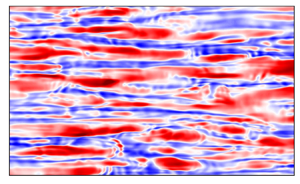Crossref Citations
This article has been cited by the following publications. This list is generated based on data provided by
Crossref.
Xu, Dehao
Wang, Jianchun
Yu, Changping
Li, Xinliang
and
Chen, Shiyi
2022.
Effect of compressibility on the small-scale structures in hypersonic turbulent boundary layer.
Physics of Fluids,
Vol. 34,
Issue. 5,
Elnahhas, Ahmed
and
Johnson, Perry L.
2022.
On the enhancement of boundary layer skin friction by turbulence: an angular momentum approach.
Journal of Fluid Mechanics,
Vol. 940,
Issue. ,
Yuan, Xianxu
Tong, Fulin
Li, Weipeng
Chen, Jianqiang
and
Dong, Siwei
2022.
Wall-attached temperature structures in supersonic turbulent boundary layers.
Physics of Fluids,
Vol. 34,
Issue. 11,
Xu, Dehao
Wang, Jianchun
Yu, Changping
Li, Xinliang
and
Chen, Shiyi
2022.
Contribution of flow topology to the kinetic energy flux in hypersonic turbulent boundary layer.
Physics of Fluids,
Vol. 34,
Issue. 4,
Ma, Rui
Gao, Zheng-hong
Lu, Lian-shan
and
Chen, Shu-sheng
2022.
Skin-friction drag reduction by local porous uniform blowing in spatially developing compressible turbulent boundary layers.
Physics of Fluids,
Vol. 34,
Issue. 12,
Xu, Dehao
Wang, Jianchun
and
Chen, Shiyi
2023.
Reynolds number and wall cooling effects on correlations between the thermodynamic variables in hypersonic turbulent boundary layers.
Journal of Fluid Mechanics,
Vol. 965,
Issue. ,
2023.
The effect of spanwise wall oscillation on spatially developing compressible transitional boundary layers.
Physics of Fluids,
Vol. 35,
Issue. 7,
Ji, Feng
Ding, Jing
Lu, Jianfeng
and
Wang, Weilong
2023.
Direct Numerical Simulation of Thermal Turbulent Boundary Layer Flow over Multiple V-Shaped Ribs at Different Angles.
Energies,
Vol. 16,
Issue. 9,
p.
3831.
Xu, Dehao
Wang, Jianchun
Yu, Changping
and
Chen, Shiyi
2023.
Artificial-neural-network-based nonlinear algebraic models for large-eddy simulation of compressible wall-bounded turbulence.
Journal of Fluid Mechanics,
Vol. 960,
Issue. ,
Xu, Dongdong
Ricco, Pierre
and
Duan, Lian
2023.
Decomposition of the skin-friction coefficient of compressible boundary layers.
Physics of Fluids,
Vol. 35,
Issue. 3,
Zhu, Yanhua
Li, Xinliang
Guo, Tongbiao
Liu, Hongwei
and
Tong, Fulin
2023.
Direct numerical simulation of slender cones with variable nose bluntness based on graphics processing unit computation.
Physics of Fluids,
Vol. 35,
Issue. 7,
Du, Yaowen
Sun, Surong
Tan, Meijing
Huang, Heji
Yan, Cong
Meng, Xian
Chen, Xuan
and
Wang, Haixing
2023.
Numerical study on the non-equilibrium characteristics of high-speed atmospheric re-entry flow and radiation of aircraft based on fully coupled model.
Journal of Fluid Mechanics,
Vol. 977,
Issue. ,
Kianfar, Armin
Di Renzo, Mario
Williams, Christopher
Elnahhas, Ahmed
and
Johnson, Perry L.
2023.
Angular momentum and moment of total enthalpy integral equations for high-speed boundary layers.
Physical Review Fluids,
Vol. 8,
Issue. 5,
Ricco, Pierre
and
Duan, Lian
2023.
Decomposition of the wall-heat flux of compressible boundary layers.
Physics of Fluids,
Vol. 35,
Issue. 6,
Gloerfelt, Xavier
Bienner, Aurélien
and
Cinnella, Paola
2023.
High-subsonic boundary-layer flows of an organic vapour.
Journal of Fluid Mechanics,
Vol. 971,
Issue. ,
Xu, Dehao
Wang, Jianchun
and
Chen, Shiyi
2023.
Wall cooling effect on spectra and structures of thermodynamic variables in hypersonic turbulent boundary layers.
Journal of Fluid Mechanics,
Vol. 974,
Issue. ,
Chen, Sanmu
Lee, HsuChew
Xu, Dehao
Wan, Minping
and
Chen, Shiyi
2023.
Decomposition of skin-friction and wall heat flux of temporal transition in compressible channel flows with direct numerical and constrained large-eddy simulations.
Physics of Fluids,
Vol. 35,
Issue. 8,
Zhang, Peng-Jun-Yi
Wan, Zhen-Hua
Dong, Si-Wei
Liu, Nan-Sheng
Sun, De-Jun
and
Lu, Xi-Yun
2023.
Conditional analysis on extreme wall shear stress and heat flux events in compressible turbulent boundary layers.
Journal of Fluid Mechanics,
Vol. 974,
Issue. ,
Zhang, Peng
Song, Yubin
and
Xia, Zhenhua
2024.
Direct numerical simulations of compressible turbulent channel flows with asymmetric thermal walls.
Journal of Fluid Mechanics,
Vol. 984,
Issue. ,
Zheng, Chaoyu
Feng, Yongliang
and
Zheng, Xiaojing
2024.
Effect of bulk viscosity on the hypersonic compressible turbulent boundary layer.
Journal of Fluid Mechanics,
Vol. 982,
Issue. ,






